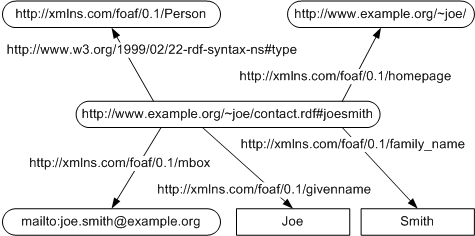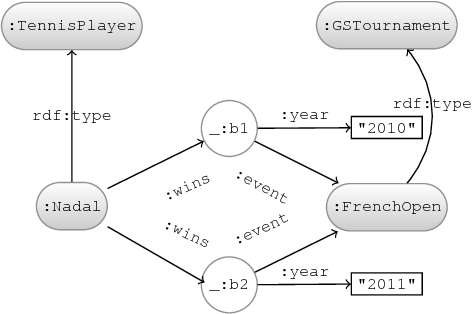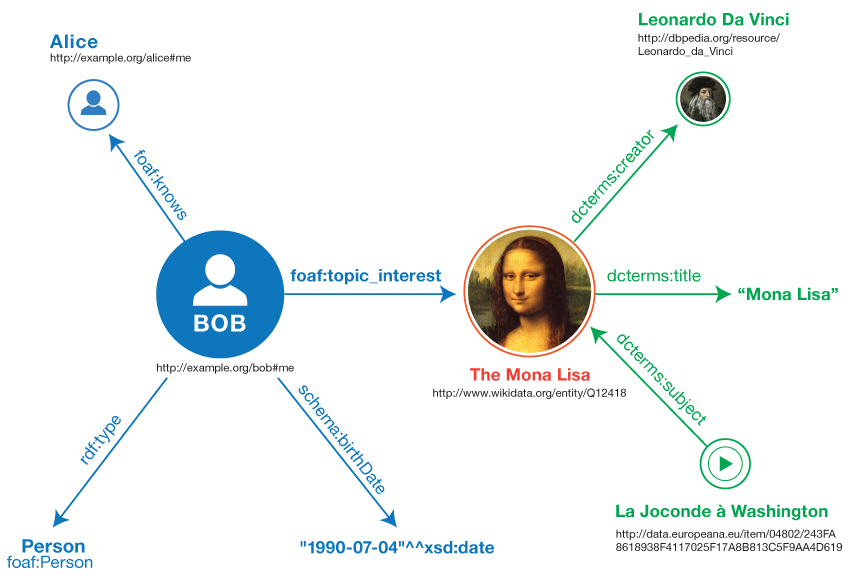RDF
Winter 2019
Instructor: Raghava Mutharaju
IIIT-Delhi

Introduction
- Resource Description Framework (RDF) is a data model that is used to describe resources
- Physical things
- Abstract concepts
- Numbers and strings
- We use the term resource and entity synonymously here
- It is a universal, machine readable data exchange format
- Resources are described using triples (subject, predicate, object)
- A triple captures the relationship (predicate) between a subject and an object
- <Delhi> <capitalOf> <India>
- RDF triple is called a RDF Statement
- Triple can be represented as a directed labelled graph

Identifiers
- URL (Uniform Resource Locator)
- It is a mechanism to specify and locate a web resource on a computer network.
- Eg: http://, ftp://
- URN (Uniform Resource Name)
- They are persistent location independent identifiers that use the urn scheme.
- Eg: ISBN of a book is a URN used to identify a book uniquely
- URI (Uniform Resource Identifier)
- It is an identifier that can uniquely and unambiguously identify resources
- ASCII encoding is used in the identifiers
- URL and URN are type of URIs. URIs and URNs need not be resolvable to a location, which is the case with URL
- Eg: http://www.w3.org/2002/07/owl#
- IRI (International Resource Identifier)
- IRI is similar to URI except that the character set for encoding the identifier is Universal Character Set (UTF-8)
- Eg: é, ö could be used in IRI
- Subject, Predicate, and Object in a triple are identified by IRIs
- http://www.example.org/~joe/contact.rdf#joesmith
- http://xmlns.com/foaf/0.1/homepage
- http://www.example/org/~joe
- Literals and blank nodes do not have IRIs
Namespace
- It is a logical grouping of unique identifiers
- Packages in Java (java.util.concurrent, org.w3c.dom)
- Namespace in C++ (std)
- XML namespace: xmlns="http://www.w3.org/1999/xhtml"
- RDF namespace: rdf="http://www.w3.org/1999/02/22-rdf-syntax-ns#"
- RDFS namespace: rdfs="http://www.w3.org/2000/01/rdf-schema#"
- XSD namespace: xsd="http://www.w3.org/2001/XMLSchema#"
Literals
- Objects in a triple can be literals
- Literals are constants. They can be values of strings, numbers, and dates
- Literal consists of the following parts
- a lexical form, which is a unicode string
- a datatype IRI
- a language tag (only for string datatype)
- "That Seventies Show"^^xsd:string
- "That Seventies Show"@en
- "La Joconde"@fr
- "1"^^xs:integer
Blank Nodes
- A blank node does not have a name associated with it
- It is similar to anonymous classes in Java, C++
- It indicates the existence of something but we will not be using or saying anything about the name of that thing

- It does not have an IRI
- Blank node identifiers have only local scope
- No global identity unlike other nodes with IRIs
- It is not a literal
- It can be used as a subject or object
Multiple Graphs
- RDF statements can be grouped into multiple graphs
- Each graph can have a name associated with it (named graphs), which is an IRI
- An RDF dataset is a collection of graphs
- Exactly one default (unnamed) graph that may be empty
- Zero or more named graphs
- Graph names are unique within a RDF dataset
- Blank nodes can be shared by graphs in a RDF dataset
- Graph name (IRI): http://example.org/bob
- <Bob> <is a> <person>.
- <Bob> <is a friend of> <Alice>.
- <Bob> <is born on> <the 4th of July 1990>.
- <Bob> <is interested in> <the Mona Lisa>.
- Graph name (IRI): https://www.wikidata.org/wiki/Special:EntityData/Q12418
- <Leonardo da Vinci> <is the creator of> <the Mona Lisa>.
- <The video 'La Joconde à Washington'> <is about> <the Mona Lisa>
RDF Serialization Formats
- There are different serialization formats for writing RDF graphs
- They are all logically equivalent and lead to same triples
- Turtle family of RDF serialization formats
- N-Triples
- Turtle
- TriG
- N-Quads
- JSON-LD
- RDFa
- RDF/XML

N-Triples
- It is a line based, plain text format to encode a RDF graph
- It is a sequence of subject, predicate, and object separated by whitespace and terminated by dot
- IRIs are written as absolute IRIs (not shortcuts) and are enclosed in angular brackets
- Literals are written in double quotes followed by datatype or language tag
- Datatype IRI is preceded by "^^"
- Language tag is preceded by "@"
- Blank nodes are expressed as _: followed by blank node label
- _:alice <http://xmlns.com/foaf/0.1/knows> _:bob .

N-Triples
- <http://example.org/bob#me> <http://www.w3.org/1999/02/22-rdf-syntax-ns#type> <http://xmlns.com/foaf/0.1/Person> .
- <http://example.org/bob#me> <http://xmlns.com/foaf/0.1/knows> <http://example.org/alice#me> .
- <http://example.org/bob#me> <http://schema.org/birthDate> "1990-07-04"^^<http://www.w3.org/2001/XMLSchema#date> .
- <http://example.org/bob#me> <http://xmlns.com/foaf/0.1/topic_interest> <http://www.wikidata.org/entity/Q12418> .
- <http://www.wikidata.org/entity/Q12418> <http://purl.org/dc/terms/title> "Mona Lisa" .
- <http://www.wikidata.org/entity/Q12418> <http://purl.org/dc/terms/creator> <http://dbpedia.org/resource/Leonardo_da_Vinci> .
- <http://data.europeana.eu/item/04802/243FA8618938F4117025F17A8B813C5F9AA4D619> <http://purl.org/dc/terms/subject> <http://www.wikidata.org/entity/Q12418> .
Turtle
- Turtle is the Terse RDF Triple Language
- It is an extension of N-Triples with syntactic shortcuts
- Namespace prefix
- Predicate lists
- Object lists
Turtle
BASE <http://example.org/>
PREFIX foaf: <http://xmlns.com/foaf/0.1/>
PREFIX xsd: <http://www.w3.org/2001/XMLSchema#>
PREFIX schema: <http://schema.org/>
PREFIX dcterms: <http://purl.org/dc/terms/>
PREFIX wd: <http://www.wikidata.org/entity/>
Turtle
- Predicate lists are triples with the same subject but different predicates and objects
- Semi colon is used as a separator
<bob#me>
a foaf:Person ;
foaf:knows <alice#me> ;
schema:birthDate "1990-07-04"^^xsd:date ;
foaf:topic_interest wd:Q12418 .
Turtle
- Object lists are triples with the same subject and predicate, but different object
- Comma is used as a separator
<ex:spiderman> foaf:name "Spiderman", "Человек-паук"@ru .
Turtle
- Two types of IRIs - relative and absolute
- Absolute IRI
- <http://one.example/subject1>
- Relative IRI
BASE <http://one.example/>
<subject1> <predicate1> <object1> .
PREFIX p: <http://one.example/>
p:subject1 p:predicate1 p:object1> .
TriG
- Extension of Turtle that supports multiple graphs
GRAPH <http://example.org/bob>
{
<bob#me>
a foaf:Person ;
foaf:knows <alice#me> ;
schema:birthDate "1990-07-04"^^xsd:date ;
foaf:topic_interest wd:Q12418 .
}
TriG
- Default graphs
<http://example.org/bob>
dcterms:publisher <http://example.org/crc> ;
dcterms:rights <http://creativecommons.org/licenses/by/3.0/> .
TriG

N-Quads
- Extends N-Triples with a fourth element to the line which is the graph IRI of the triple
<http://example.org/bob#me> <http://www.w3.org/1999/02/22-rdf-syntax-ns#type> <http://xmlns.com/foaf/0.1/Person> <http://example.org/bob> .
<http://example.org/bob#me> <http://xmlns.com/foaf/0.1/knows> <http://example.org/alice#me> <http://example.org/bob> .
<http://example.org/bob> <http://purl.org/dc/terms/publisher> <http://example.org> .
<http://example.org/bob> <http://purl.org/dc/terms/rights> <http://creativecommons.org/licenses/by/3.0/> .
JSON-LD
- Provides JSON sytanx for RDF graphs
- JSON-LD can be used to transform JSON to RDF
- JSON objects are given universal identifiers in JSON-LD
- This helps in referring to objects in other JSON documents anywhere on the Web
JSON-LD
{
"@context": "example-context.json",
"@id": "http://example.org/bob#me",
"@type": "Person",
"birthdate": "1990-07-04",
"knows": "http://example.org/alice#me",
"interest": {
"@id": "http://www.wikidata.org/entity/Q12418",
"title": "Mona Lisa",
"subject_of": "http://data.europeana.eu/item/04802/243FA8618938F4117025F17A8B813C5F9AA4D619",
"creator": "http://dbpedia.org/resource/Leonardo_da_Vinci"
}
}
RDFa
- It is used to embed RDF within HTML and XML documents
- Search engines can make use of the structured data (schema.org, Rich Snippets) to enrich search results
RDFa
<body prefix="foaf: http://xmlns.com/foaf/0.1/
schema: http://schema.org/
dcterms: http://purl.org/dc/terms/">
<div resource="http://example.org/bob#me" typeof="foaf:Person">
<p>
Bob knows <a property="foaf:knows" href="http://example.org/alice#me">Alice</a>
and was born on the <time property="schema:birthDate" datatype="xsd:date">1990-07-04</time>.
</p>
<p>
Bob is interested in <span property="foaf:topic_interest"
resource="http://www.wikidata.org/entity/Q12418">the Mona Lisa</span>.
</p>
<</div>
</body>
RDF/XML
- Provides XML syntax for RDF graphs
- There is good tool support for XML
- This used to be the only syntax that was available to serialize RDF
RDF/XML
<?xml version="1.0" encoding="utf-8"?>
<rdf:RDF
xmlns:dcterms="http://purl.org/dc/terms/"
xmlns:foaf="http://xmlns.com/foaf/0.1/"
xmlns:rdf="http://www.w3.org/1999/02/22-rdf-syntax-ns#"
xmlns:schema="http://schema.org/">
<rdf:Description rdf:about="http://example.org/bob#me">
<rdf:type rdf:resource="http://xmlns.com/foaf/0.1/Person"/>
<schema:birthDate rdf:datatype="http://www.w3.org/2001/XMLSchema#date">1990-07-04</schema:birthDate>
<foaf:knows rdf:resource="http://example.org/alice#me"/>
<foaf:topic_interest rdf:resource="http://www.wikidata.org/entity/Q12418"/>
</rdf:Description>
</rdf:RDF>
RDFS
- RDFS is a semantic extension of RDF
- It provides the vocabulary for the RDF data
- It provides a mechanism to describe groups of related resources (classes) and the relationships between these resources (properties)
- Classes
- Related resources can be categorized as a class
- A class is defined using rdfs:Class
- Members of the class are known as instances
- Classes can be subclass of another class. This is defined using rdfs:subClassOf
- A Resource is the class of everything, i.e., class of all classes
- Properties
- It is a relation between subject resources and object resources
- A property/predicate is defined using rdf:Property
- Subproperties can be stated using rdfs:subPropertyOf
- hasSon rdfs:subPropertyOf hasChild
- A property can have domain and range, which can be defined using rdfs:domain and rdfs:range respectively
-
- If multiple domains/ranges are defined then the domain/range of the property is the intersection of all the defined domains/ranges
- Other frequently used RDFS schema elements
- rdf:type
- rdfs:Literal
- rdfs:label
- rdfs:comment
Examples
- Person rdf:type rdfs:Class .
- Father rdfs:subClassOf Person .
- hasAge rdf:type rdf:Property .
- hasSon rdfs:subPropertyOf hasChild .
- hasAge rdfs:domain Person
- hasAge rdfs:range rdfs:Literal .
- wd:Q12418 rdfs:Label "Mona Lisa" .
- wd:Q12418 rdfs:comment "Wikidata ID for Mona Lisa" .
Reification
- Used to capture provenance information
- Describe other RDF statements using statements
exproducts:triple12345 rdf:type rdf:Statement .
exproducts:triple12345 rdf:subject exproducts:item10245 .
exproducts:triple12345 rdf:predicate exterms:weight .
exproducts:triple12345 rdf:object "2.4"^^xsd:decimal .
exproducts:triple12345 dc:creator exstaff:85740 .
Entailment Rules
Conventions
- We use the following conventions in the entailment rules
- S represents an RDF graph
- aaa, bbb represents predicate of a triple
- xxx, yyy, zzz represents either the subject or object of a triple
- sss represents a literal
- ddd represents a datatype
RDF Entailment Patterns
| If S contains | then S RDF entails | |
|---|---|---|
| rdf1 | xxx aaa "sss"^^ddd . |
xxx aaa _:nnn . _:nnn rdf:type ddd . |
- If ex:a ex:p "123"^^xsd:integer . then
- ex:a ex:p _:x . and
- _:x rdf:type xsd:integer .
RDF Entailment Patterns
| If S contains | then S RDF entails | |
|---|---|---|
| rdf2 | xxx aaa yyy . | aaa rdf:type rdf:Property . |
- If ex:a ex:p "123"^^xsd:integer . then
- ex:p rdf:type rdf:Property .
RDFS Entailment Patterns
| If S contains | then S RDFS entails | |
|---|---|---|
| rdfs1 | xxx aaa "sss"^^ddd . | ddd rdf:type rdfs:Datatype . |
- If ex:a ex:p "123"^^xsd:integer . then
- xsd:integer rdf:type rdfs:Datatype .
RDFS Entailment Patterns
| If S contains | then S RDFS entails | |
|---|---|---|
| rdfs2 |
aaa rdfs:domain xxx . yyy aaa zzz . |
yyy rdf:type xxx . |
- If ex:worksAt rdfs:domain ex:Employee . and
ex:john ex:worksAt ex:ibm . then - ex:john rdf:type ex:Employee .
RDFS Entailment Patterns
| If S contains | then S RDFS entails | |
|---|---|---|
| rdfs3 |
aaa rdfs:range xxx . yyy aaa zzz . |
zzz rdf:type xxx . |
- If ex:worksAt rdfs:range ex:Organization . and
ex:john ex:worksAt ex:ibm . then - ex:ibm rdf:type ex:Organization .
RDFS Entailment Patterns
| If S contains | then S RDFS entails | |
|---|---|---|
| rdfs4a | xxx aaa yyy . | xxx rdf:type rdfs:Resource . |
| rdfs4b | xxx aaa yyy . | yyy rdf:type rdfs:Resource . |
RDFS Entailment Patterns
| If S contains | then S RDFS entails | |
|---|---|---|
| rdfs5 |
xxx rdfs:subPropertyOf yyy . yyy rdfs:subPropertyOf zzz . |
xxx rdfs:subPropertyOf zzz . |
RDFS Entailment Patterns
| If S contains | then S RDFS entails | |
|---|---|---|
| rdfs6 | xxx rdf:type rdf:Property . | xxx rdfs:subPropertyOf xxx . |
RDFS Entailment Patterns
| If S contains | then S RDFS entails | |
|---|---|---|
| rdfs7 |
aaa rdfs:subPropertyOf bbb . xxx aaa yyy . |
xxx bbb yyy . |
- If ex:hasSon rdfs:subPropertyOf ex:hasChild . and
ex:john ex:hasSon ex:mike . then - ex:john ex:hasChild ex:mike .
RDFS Entailment Patterns
| If S contains | then S RDFS entails | |
|---|---|---|
| rdfs8 | xxx rdf:type rdfs:Class . | xxx rdfs:subClassOf rdfs:Resource . |
RDFS Entailment Patterns
| If S contains | then S RDFS entails | |
|---|---|---|
| rdfs9 |
xxx rdfs:subClassOf yyy . zzz rdf:type xxx . |
zzz rdf:type yyy . |
- If ex:Employee rdfs:subClassOf ex:Person . and
ex:john rdf:type ex:Employee . then - ex:john rdf:type ex:Person .
RDFS Entailment Patterns
| If S contains | then S RDFS entails | |
|---|---|---|
| rdfs10 | xxx rdf:type rdfs:Class . | xxx rdfs:subClassOf xxx . |
RDFS Entailment Patterns
| If S contains | then S RDFS entails | |
|---|---|---|
| rdfs11 |
xxx rdfs:subClassOf yyy . yyy rdfs:subClassOf zzz . |
xxx rdfs:subClassOf zzz . |
RDFS Entailment Patterns
| If S contains | then S RDFS entails | |
|---|---|---|
| rdfs12 | xxx rdf:type rdfs:ContainerMembershipProperty . | xxx rdfs:subPropertyOf rdfs:member . |
- If ex:CarBrandsBag rdf:_1 ex:honda . and
ex:CarBrandsBag rdf:_2 ex:toyota .
rdf:_1 rdf:type rdfs:ContainerMembershipProperty . then - rdf:_1 rdfs:subPropertyOf rdfs:member .
RDFS Entailment Patterns
| If S contains | then S RDFS entails | |
|---|---|---|
| rdfs13 | xxx rdf:type rdfs:Datatype . | xxx rdfs:subClassOf rdfs:Literal . |
Representing Knowledge using RDF
- Online RDF Editor: http://linkeddata.uriburner.com/rdf-editor/
- Online RDF Visualization: http://visgraph3.org/
- Domain: Delhi Public Transportation
- Road Transport (Bus, AutoRickshaw, Taxi, CycleRickshaw)
- Rail Transport (Metro)
- Air Transport
- Properties: hasCapacity, hasLocation, hasSource, hasDestination
- Pick a domain of your choice and build an RDF graph
RDF Editors
- http://linkeddata.uriburner.com/rdf-editor/
- https://bitbucket.org/dotnetrdf/dotnetrdf/wiki/UserGuide/Tools/rdfEditor
- http://www.linkeddatatools.com/rdf-studio
- https://marketplace.eclipse.org/content/komma-rdf-eclipse
- https://github.com/AKSW/Xturtle
- https://atom.io/packages/language-rdf
- https://github.com/e-e-e/sublime-turtle-syntax, https://github.com/abcoates/sublime-text-turtle-sparql
- https://sourceforge.net/projects/veudas/
RDF Visualization Tools
- http://www.easyrdf.org/converter
- http://rhizomik.net/html/redefer/rdf2svg-form/
- https://github.com/usc-isi-i2/ontology-visualization
- https://franz.com/agraph/gruff/
- https://github.com/idafensp/ar2dtool
- https://github.com/dyreriket/rdfvizler
- http://activearchives.org/wiki/Visualizing_RDF
- http://visgraph3.org/
RDF Validators
References
- Foundations of Semantic Web Technologies. Pascal Hitzler et. al. CRC Press.
- RDF 1.1 Primer
- RDF 1.1 Schema
- RDF 1.1 Turtle
- RDF 1.1 Semantics